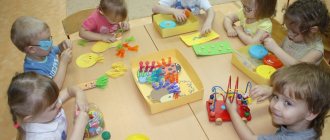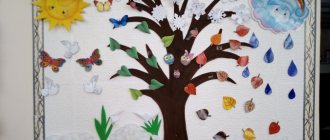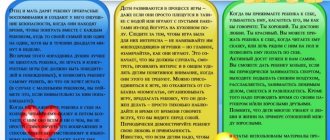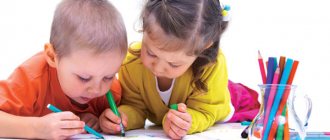What do you need to know about SanPiN in preschool institutions?
Sanitary and hygienic rules and regulations for preschool institutions are approved by SanPiN 2.4.1.3049-13.
The act, approved by the Decree of the Chief Sanitary Doctor of the Russian Federation dated May 15, 2013 No. 26, includes rules governing the organization of the organization and the rules for the use of accessories for children accepted into groups.
The act establishes requirements for:
- location of the preschool educational institution;
- equipment, including its location;
- maintenance of territories related to a children's educational institution;
- maintenance, decoration of premises, the building itself;
- lighting of rooms, as well as auxiliary premises (natural and artificial);
- heating, water supply, ventilation, sewerage and other systems;
- the formation of groups that accept children with diseases that limit their health;
- admission of minors to organizations implementing preschool education programs;
- organization of the regime and educational process, including training;
- equipment, inventory, toys, dishes and equipment in the catering department;
- conditions of preparation, storage of food, menu preparation;
- transportation, food intake;
- hygienic, anti-epidemic measures;
- compliance with sanitary standards.
All of the above requirements must be strictly observed by employees of preschool institutions.
For refusal to comply with the rules, citizens and organizations face a hefty fine. Next we will talk about labeling furniture and utensils in preschool educational institutions.
Organization of a subject-developmental environment in the junior group of preschool educational institutions according to the Federal State Educational Standard
Organization of a subject-developmental environment in the younger group
Author : Olga Vladimirovna Bobkova, Educator of MBDOU kindergarten No. 4 “Fairy Tale”. Description : my methodological development will be useful to kindergarten teachers; in my work I described in detail how to design the environment of the junior group so that it complies with the Federal State Educational Standard, develops children and reveals their individuality.
There is no aspect of upbringing that is not influenced by the situation, there is no ability that is not directly dependent on the concrete world immediately surrounding the child... Anyone who manages to create such an environment will make his work extremely easy.
Among it, the child will live - develop his own self-sufficient life, his spiritual growth will be improved from himself, from nature... E. I. Tikheyeva One of the important conditions for educational work in a preschool institution is the correct organization of the subject-developmental environment.
A properly organized developmental environment will allow each child to find something they like, to believe in their strengths and abilities, to learn to interact with teachers and peers, to understand and evaluate their feelings and actions, and this is precisely what lies at the heart of developmental education. The developing subject environment is the main means of shaping the child’s personality and is the source of his knowledge and social experience. The environment surrounding children in kindergarten should ensure the safety of their lives, promote health and strengthen the body of each of them. The organization of a subject-developmental environment in a kindergarten carries the effectiveness of educational influence aimed at developing in children an active cognitive attitude towards the surrounding world of objects, people, and nature. It should be formed taking into account certain principles developed in the works of leading teachers, in particular, taking into account the age of the children, since each age group has its own specific psychological and pedagogical characteristics. When creating a subject-development environment in the second younger group, we relied on the principle of activity , stability, flexible zoning. The group has created conditions for children to interact with the teacher and with each other. There is also a corner of solitude, which gives the child a sense of psychological security and helps personal development. We try to enrich the environment with elements that would stimulate the cognitive, developmental, motor and other activities of children. The content of the subject-development environment corresponds to the interests of boys and girls, periodically changes, varies, and is constantly enriched. Functions of the subject-development environment in the younger group: Cognitive – satisfies the child’s need to master the world around him, stimulates cognitive activity; Communicative – stimulates speech development, allows the child to learn the basics of communication and interaction; Wellness – stimulates motor activity, enriches motor experience, introduces to the culture of health; Creative – introduces children to creative activities, promotes self-development and self-realization. In our group, the subject-development environment is divided into micro-centers for children’s independent activities: Center for role-playing games. Objectives: to promote the emergence of the game; develop the ability to choose a role and perform several interrelated actions in the game; formation of communication skills in the game; development of imitation and creative abilities. Learn to use building materials in games. Equipment and materials that we have in our corner: doll furniture for the room and kitchen; ironing board; attributes for playing “House”, “Shop”, “Barbershop”, “Hospital”, “Drivers”, etc.; dolls; toy wild and domestic animals; sets of kitchen and tea utensils; a set of vegetables and fruits; large and medium-sized cars; trucks and cars; telephone, steering wheel, scales, bags, buckets, iron, hammer, etc.; doll strollers; fun toys; clothing for dressing up. The main activity of our kids is play. The playroom contains toys that introduce children to the everyday objects around them. Kids get acquainted with objects that are new to them and learn to operate with them. The acquired knowledge and skills are transferred to everyday life. Nature Center: Objectives: Environmental education and education of children. Foster love and respect for nature.
Physical Culture Center: Objectives: To create conditions for physical exercise in a group, to stimulate children’s desire to engage in physical activity. To instill in children a conscious attitude towards their health. Strengthening the muscles of the lower and upper extremities, preventing flat feet; prevention of colds; strengthening the muscles of the spinal column, preventing scoliosis. Equipment and materials that we have in our corner: rugs, massage paths, with footprints (to prevent flat feet); gymnastic sticks; balls; hoops; jump ropes; skittles; cubes; balls, handkerchiefs, long and short cord; bags with cargo; ribbons of different colors; checkboxes; attributes for outdoor games and morning exercises. The need for movement is an important task when organizing a subject-development environment.
Center for Fine Arts: Objectives: To develop interest, attention, curiosity, emotional response of children to individual aesthetic properties and qualities of objects in the surrounding reality. Equipment and materials that are in the corner: sets of colored pencils; sets of felt-tip pens; ballpoint pens; albums, gouache; watercolor; colored wax crayons, etc.; brushes - thin and thick; jars for washing paint brushes; drawing paper of various sizes; stencils by topic; plasticine; stacks; signets; fabric napkins, docks for drawing with felt-tip pens and chalk, stencils for plasticine printing, water and regular coloring books, PVA glue, all kinds of figures for applique.
Musical and theatrical center: Objectives: Development of auditory perception and attention; formation of performing skills; development of children's creativity based on literary works. Equipment and materials that we have in our corner: a set of noise boxes; sounding toys, contrasting in timbre and nature of sound production (bells, tambourine, pipes, metallophone, drum, rubber tweeters, rattles, etc.); musical educational games; table theater, shadow theater, flannelgraph, small screen and sets of puppets (finger, flat, etc.), masks, caps, for staging fairy tales, homemade costumes.
Children are delighted with our music and theater center. Musical instruments bring children many joyful moments and develop phonemic hearing and a sense of rhythm. We try to introduce children to various types of theater. Meeting with a doll helps children relax, relieve tension, and create a joyful atmosphere. Book Center: Objectives: Formation of listening skills, ability to handle a book; Formation and expansion of ideas about the environment. Equipment and materials that we have in the corner: a bookcase, a table and two chairs; books according to the program, children's favorite books, baby books, toy books; albums for viewing: “Professions”, “Seasons”, “Kindergarten”; an album with family photographs of the group's children; sets of subject and subject pictures; games on cognitive and speech development, etc. In the group’s book showcase, I usually display 4-5 books, usually already familiar to children, with bright, large illustrations. The length of time a book stays in a corner is determined by the children’s interest in this book. On average, her stay there is 2-2.5 weeks. In the corner, I give children the first lessons in independent communication with a book: I introduce them to the corner of the book, its structure and purpose, teach them to look at books only there (take books with clean hands, leaf through carefully, do not tear, do not wrinkle, do not use for games; after I looked, always put the book in its place). My kids love it when we read books and look at pictures with them, so here we have a lot of bright, colorful and interesting literature on the program.
Center for sensory and speech development.
Objectives: Performs a calming and relaxing function. The child can relax, be alone with himself, play educational games, watch a book or just dream. Reducing the level of anxiety, psychological stress, improving mood. Materials and equipment: A jar of “Aggression”, a mirror, games “Emotions”, “My Mood”, a box “Mirilochka”, chairs for bad and good moods, family photo albums, soft toys, handmade toys, pebbles.
A properly organized developmental environment allows every child to find something they like, to believe in their strengths and abilities, to learn to interact with teachers and peers, to understand and evaluate their feelings and actions, and this is precisely what lies at the heart of developmental education. The subject-developmental environment of the group is as close as possible to the interests and needs of each preschooler. We tried to ensure that the child had the opportunity to do what he loved in the mini corner of his choice. Everything in the group is accessible to every child, is age appropriate and takes into account their individual characteristics and developmental capabilities. Conditions have been created for the accumulation of creative experience, the application of one’s knowledge and skills, in situations of action with familiar or completely unfamiliar objects. The subject-spatial environment of the group creates a comfortable mood and promotes the emotional well-being of children.
We recommend watching:
Mini-museums in my kindergarten group Federal State Educational Standard in preschool education Curriculum of MBDOU in accordance with the Federal State Educational Standard for preschool education Round table in a preschool educational institution in accordance with the Federal State Educational Standard
Similar articles:
Do-it-yourself group decoration in kindergarten
DIY Autumn panel






